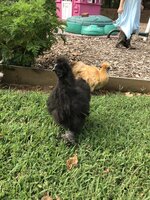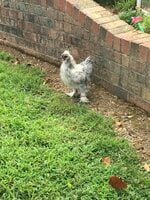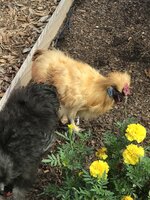Unfortunately in the US , there is only one standard of perfection for Silkies that says they are all bantam... This is FAR from what I would call reality and some should truly not be called bantam. In the UK they have two standards... one for bantam and one for large fowl Silkies. And on here, I have seen people crossing Silkies to Brahma and giant Cochin or others... when bred back the second generation will produce a percentage of "silkie" feathered offspring... just for informational purposes.There really is a big difference in size with these guys.

With places like Meyer's (actually one of my preferred hatcheries over others) you get ZERO consistency. And as far as I know they do not even attempt to sex their bantams. The only place I know of that does offer sexed bantams is My Pet Chicken.
I have had Silkies crow as young as 4 weeks, egged on by my dogs howling. My friend has a roo who didn't crow until 1.5 years old! But her smallest Silky is a lavender male, I regret giving her because he attacks EVERYONE except her husband, and he won't do anything about it.

Rose is a comb type, not a color. Lot's of Silkies do sport red instead of mulberry combs because folks don't select for the standard of perfection (dark skin) and just breed anything that comes close... no rudeness meant here with regards to your birds!
It's also true that some lines have larger combs on their birds than those that do breed selectively, I have even gotten a straight comb... The hatch date on your shipping info should be accurate as they can otherwise not really ship successfully once yolk has been utilized by chicks.
My assessment of all three being male is according to feathering in addition to comb and wattle development at the age... noting the bearding gene inhibits wattle size. While it's difficult to make out, boys still get the longer saddle feather that hang more flow-ee than the females. Also on the back of their heads, the feathers grow into more of a billy ray cyrus look while the females keep more of a cheer leader pom pom... Some will call them streamers and it can be tricky as at this age they are still going through mini molts on their way to adult plumage. Lastly, not in every bird but many the ears are so much more prevalent and beautiful on the boys. The gals lobes don't get as large.
While the buff may be the smallest... it's also from a different line... AND I have experienced the same thing from the same breed and variety, same hatch date and hatchery.
My experience says all those are cockerels. PLEASE, tag me or quote me when you discover the entire truth... as I am hear to learn and don't mind being wrong... even HOPE I am for you!


Old farmers say a lot of things.. don't make them right.
 (friendly intent here)
(friendly intent here)









 I may have
I may have